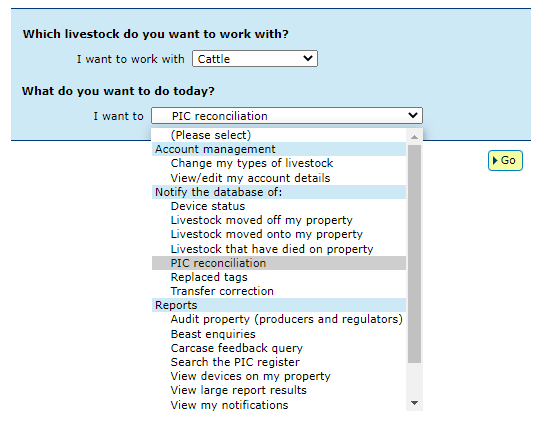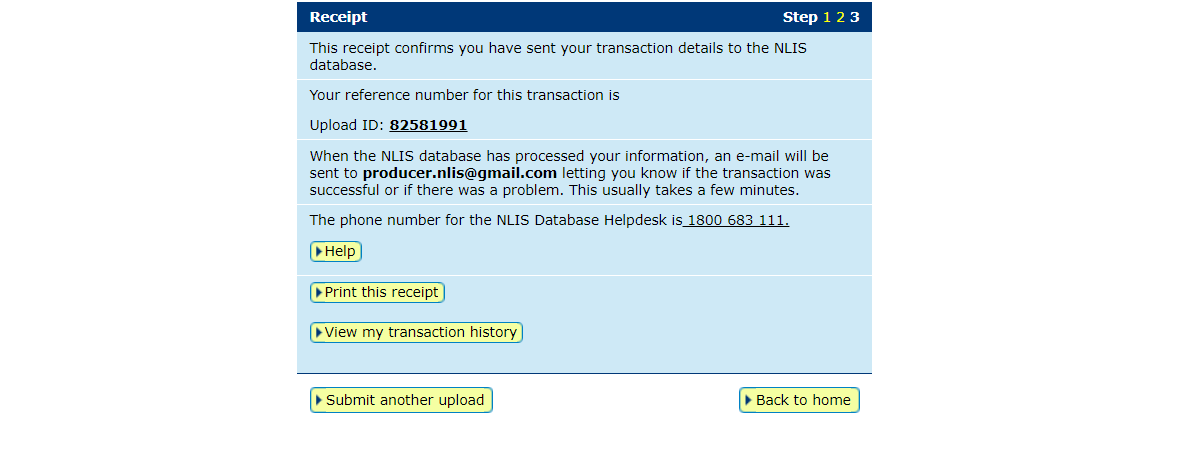NLIS how-to guides
Need help or guidance accessing the NLIS database? Our series of NLIS how-to guides are here to help. Simply answer the questions in the drop down boxes below.
Please note: The NLIS database will be unavailable between 6.00pm and 8.00pm (AEDT) every second Thursday, for routine maintenance. View the NLIS maintenance dates.
If you need further help please contact ISC Customer Service on 1800 683 111 (Monday - Friday between 8am-7pm AEST) (Saturday - Sunday between 9am - 5pm AEST) or email info@integritysystems.com.au.
How-to: Conduct a PIC reconciliation - by file upload
A PIC reconciliation is a stocktake of all electronic NLIS devices on a property. This process identifies discrepancies between the total number of electronic devices physically on a property and the number of electronic devices registered to that property (PIC) on the NLIS database.
All devices/tags purchased on your PIC – those attached to livestock and those not yet used – are considered ‘active’ tags. The database does not differentiate between devices/tags applied to animals and those still in the cupboard.
This database action will identify the specific differences between the NLIS records and the devices/tags on your property. The results generated by completing this process will assist you to take further action to ensure your device/tag records in the NLIS database are accurate.
ISC recommends completing a PIC reconciliation either annually or on a regular basis appropriate to your operation.
Before you start
- Gather the NLIS ID or RFID details of all the devices/tags physically on your PIC into one .csv file (Microsoft Excel).
Preparing a .csv file for a PIC reconciliation can be achieved by scanning or recording all devices at an annual muster or on an ongoing basis at times convenient to usual management practices such as when you are moving stock, at weaning, preg-testing or when accounting for deaths.
A PIC reconciliation is a whole of PIC review, not a paddock-by-paddock glance, therefore the .csv file needs to contain every active tag.
*Quick Tip: All devices/tags purchased on your PIC are considered ‘active’ tags. The database does not differentiate between devices/tags applied to animals and those not yet used. This means that all unused tags must be included in the reconciliation.
Your .csv file only needs two columns of data, the PIC (in column A) and the tag (in column B) like shown:

Log in to the NLIS database at nlis.com.au with your username and password.
*QuickTip: A myMLA account can provide access to your NLIS and LPA accounts with just one username and password. Link your accounts today.
How-to: In brief
1
Select species and 'PIC Reconciliation' action > Go > continue.
2
Click 'upload a file' and choose the file from your computer > Continue then > Send.
3
Check your email inbox to view the results and assess the attachments to action.
4
Return to the database to correct any differences:
- Assign or remove the inactve device status
- Move livestock onto your property
How-to: Step-by-step
Step 1
Once logged into the NLIS database, select the species you are working with and the action ‘PIC reconciliation’. Click ‘Go’. Then click ‘Continue’.

Step 2
Click on ‘Upload a file’ then click on ‘Choose File’.
A pop-up window will appear for you to browse the files on your computer to locate the .csv file you have prepared that lists all the electronic tags on your property. Once located, select the file and click ‘Open’.
The NLIS database window (pictured right) will have your file name included, so click ‘Continue’, then on the next confirmation window, click ‘Send’.

*Quick Tip: Once you have uploaded your file and clicked ‘Send’, you will see a ‘Receipt’ notice on the screen. This will advise if the upload was successful. If not, return to the home page to commence the actions again from Step 1.
Step 3
Check your emails for a new email from ‘nlis.support’ to view the PIC reconciliation results. These will be provided in up to four excel spreadsheets contained in a .zip folder. Open the folder and then open the files to view the details of the results.
*QuickTip: A .zip folder allows the database to condense large files for sending via email. To open the .zip folder, just double-click it. Then, if needed for future reference, save the file on your computer.
Step 4
With the information received via email, you will likely need to return to the NLIS database to start tidying up the differences. You will know if this is required by checking the detail in the spreadsheet results and understanding what it means. If a spreadsheet listed below was not included in an email to you, then that information on the database is accurate and no action is required.
What do the files detail?
>File: Devices not on PIC.csv – These devices/tags were included in the list you submitted, however the NLIS database has them on another property. That means they:
- Have not yet been transferred onto your property
- Have been transferred off the PIC after you scanned your livestock.
ACTION REQUIRED: You will need to transfer any devices/tags identified as ‘not currently on the PIC’ onto your property through the Livestock moved onto my property action.
Devices/tags that have left your property since you scanned them can be disregarded.
Don’t forget you can contact ISC Customer Service on 1800 683 111 for clarification if required.
>File: Devices to be made Inactive.csv – These are usually from animals that have died in the paddock, lost their tags, or, more commonly, you have sold but the transfer was not recorded.
ACTION REQUIRED: You will need to change the status of the tag to inactive through the Device status action. Click on the link to view this How-to.
>File: Devices to be made active.csv – These are tags that have previously been set to inactive. They might have been missed at your last PIC reconciliation or were set to inactive but have now been found.
ACTION REQUIRED: You will need to change the status of the tag through the Device status action.
*QuickTip: These spreadsheets are in the correct format to be uploaded to the NLIS database. Simply save each one to your computer and upload it using the required action.
>File: Active devices.csv
This spreadsheet lists the devices currently on your property that match the record on the database. This list is for your reference and requires no further action.
Step 5
As you complete the actions from each, file, the database will provide a receipt on-screen. It’s recommended to record the Upload ID (or to print this receipt for reference) and click ‘View my transaction’ history to confirm the status of your transaction.

*QUICK TIP: To ensure the transfer was received by database, click ‘View my transaction history’ to check the status of your ‘Upload ID’ is marked as Complete. If another status is shown, you will need to read the generated email for specific details about the outcome. These other status notes may be:
- Warning: the transfer is complete but a tag or tags were marked with a message that you will need to investigate / review.
- Error: One or more tags were not able to be moved and need your review / investigation.
- Failure: Technical issues occurred with the database and the movement was not completed.
- Bad Format: There were errors in the preparation of the .csv Microsoft excel file. Review and or contact ISC Customer Service on 1800 683 111.